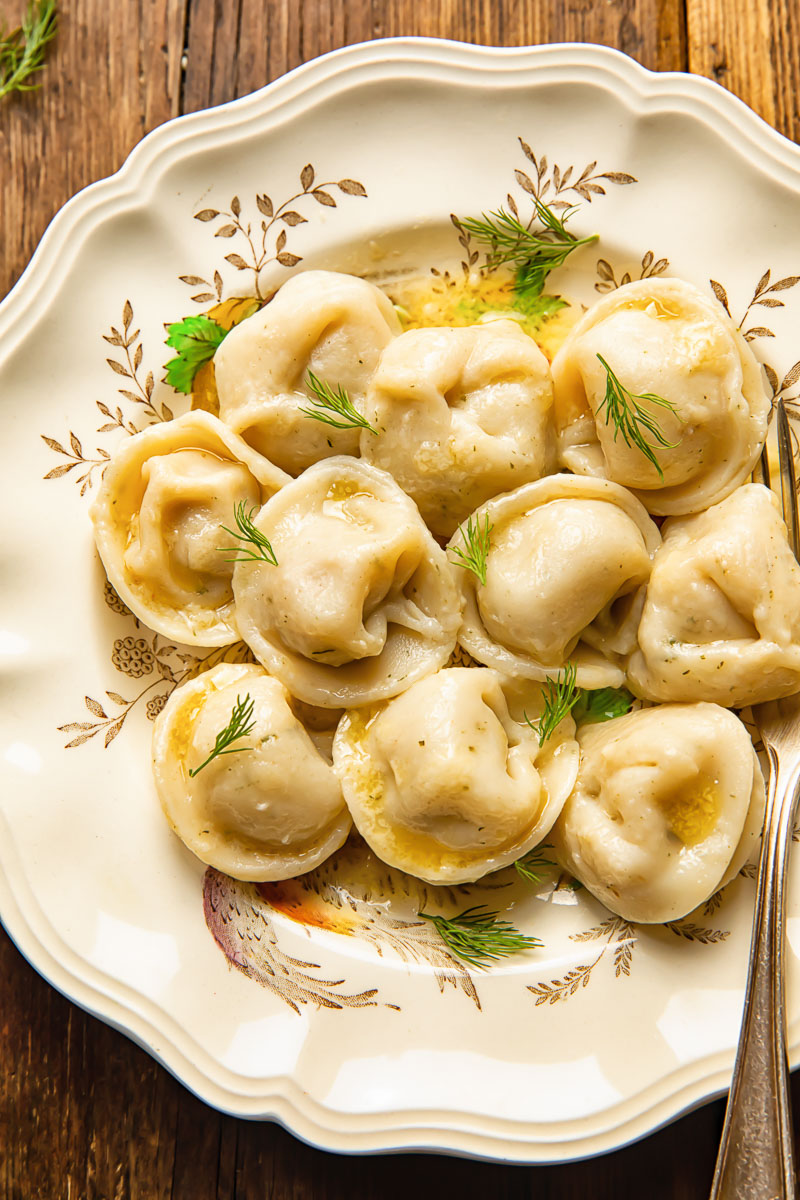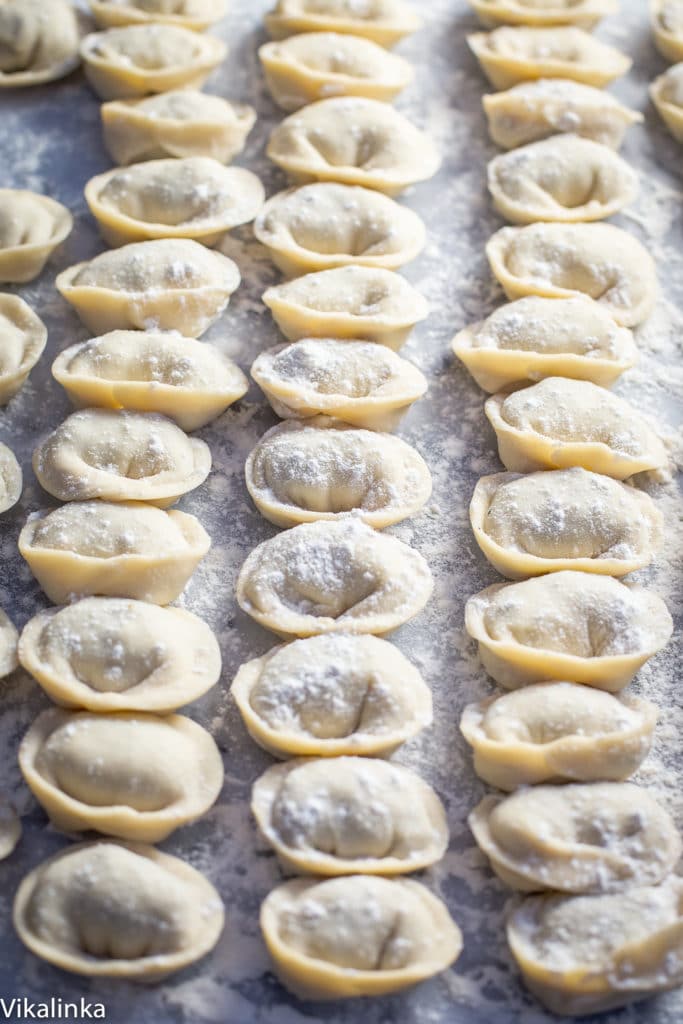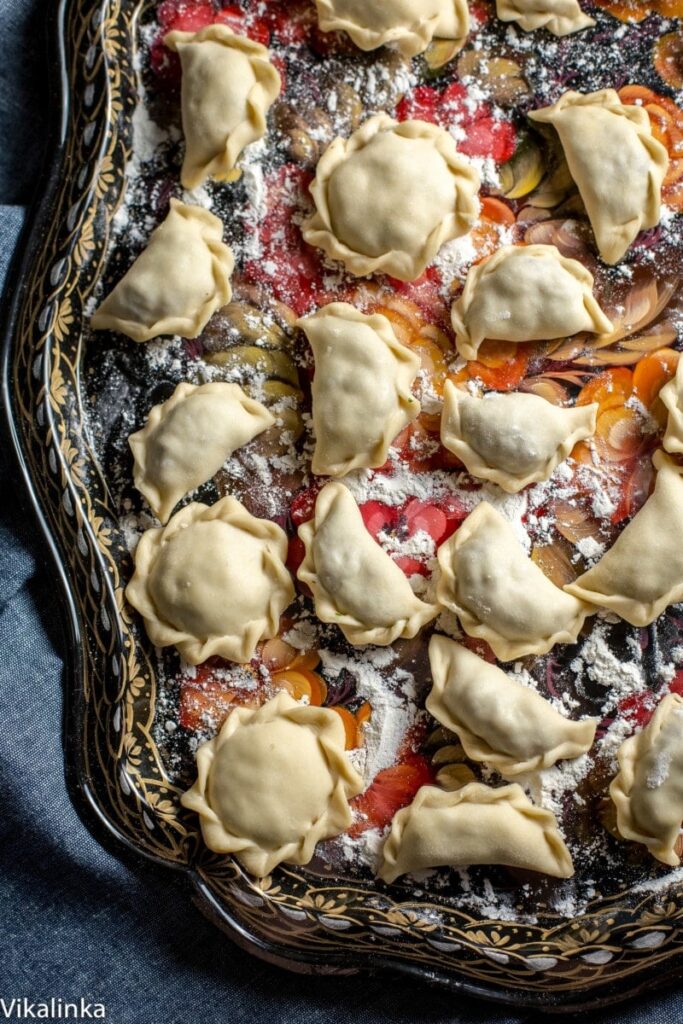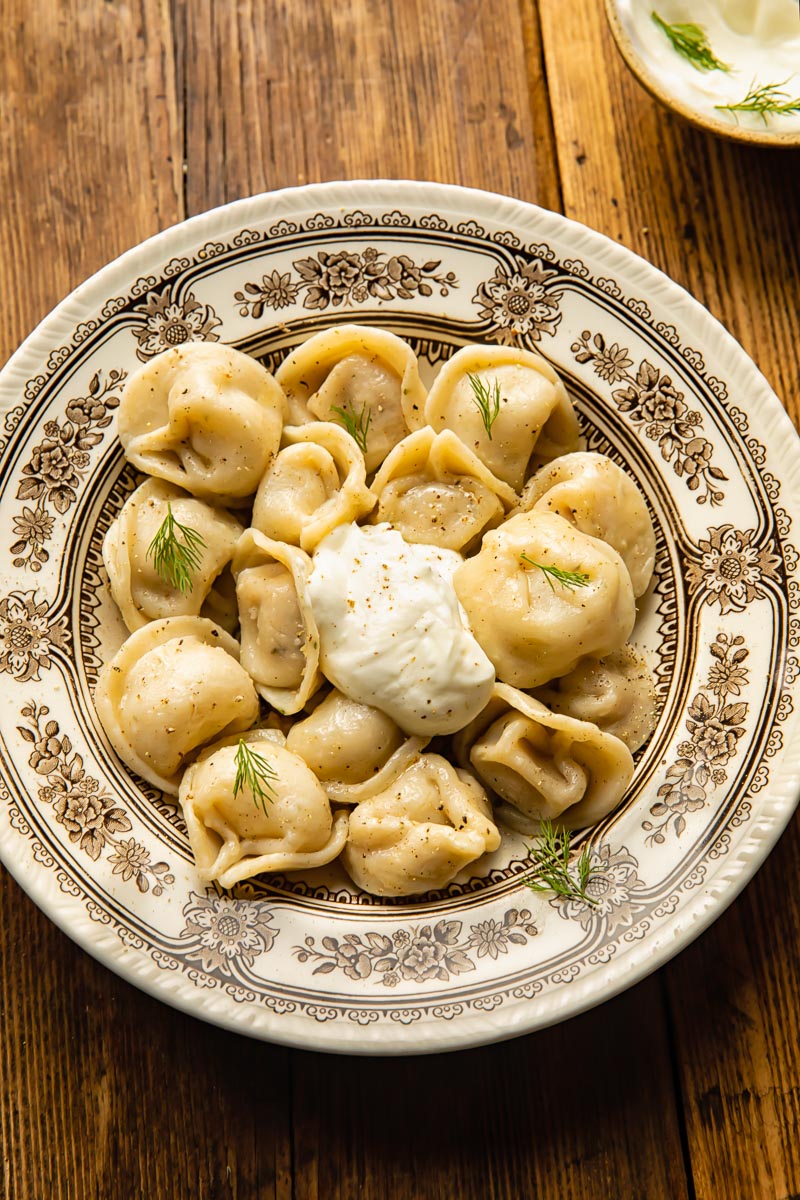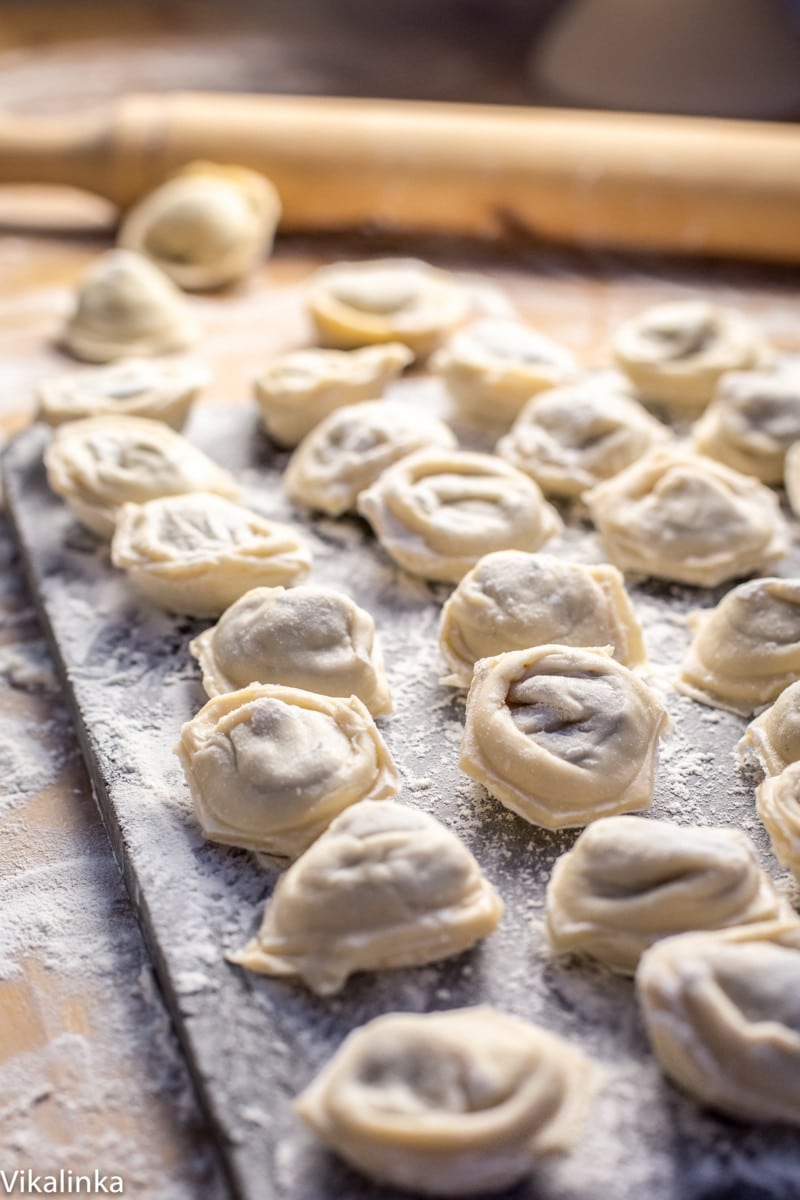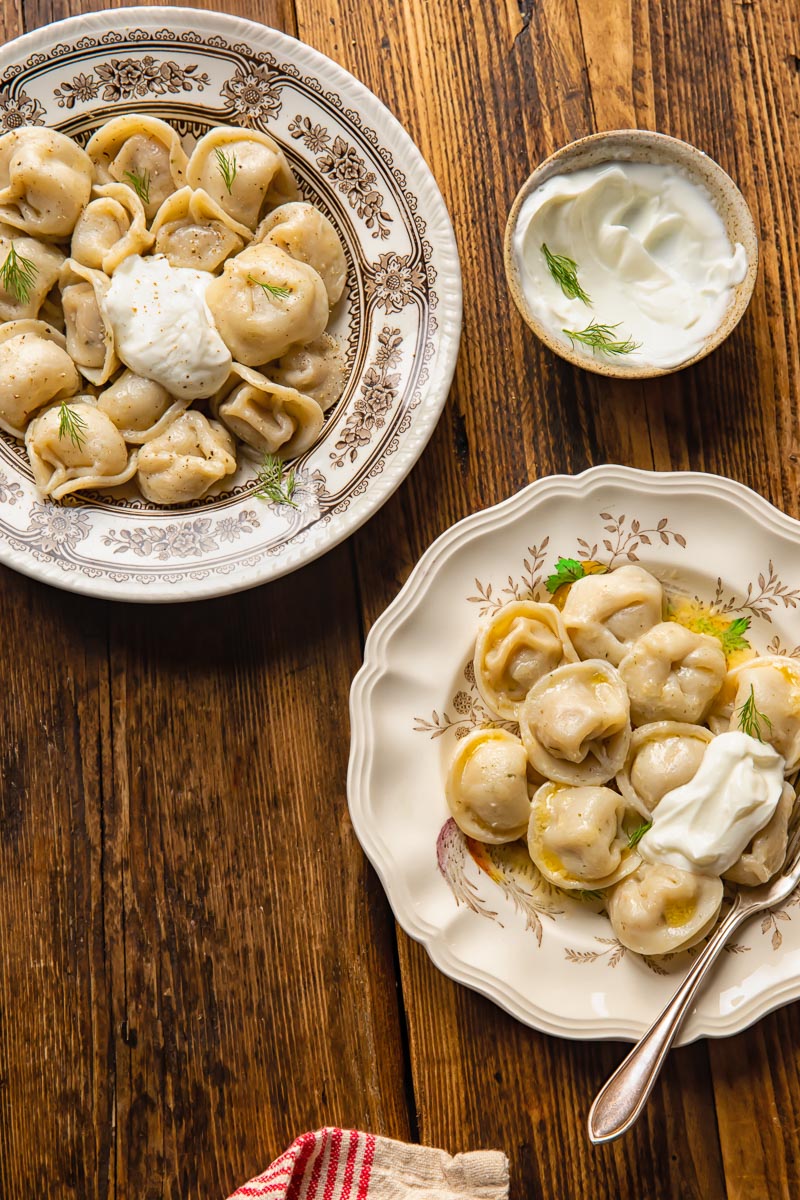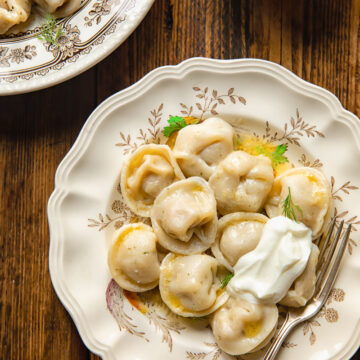If you have too much filling leftover, you can mix it with rice and stuff bell peppers with it or make porcupine meatballs. I am grinning from ear to ear just looking at these little beauties! Making Siberian Pelmeni and sharing them with you have been on my list ever since I started blogging years ago! I cannot even begin to tell you what an emotional attachment I have to these meat dumplings! They were always in our freezer at home, ready to be pulled out whenever we needed a quick and hearty meal. And they still are! We always have a selection ready to go and no one complains when they are placed on the table. And why would they? Savoury, juicy and filled with a tender meat filling. Give them a try and they’ll find a permanent place on your table as well!
Siberian Pelmeni
If you ever ask me what defines Russian food, pelmeni would be without a doubt at the top of my list. And if you ever ask me what I like to eat when I am sad or happy pelmeni would be way up there as well. If you ever ask me what Russian food I would like to teach my children, these meat dumplings will be my most earnest answer. After all, that is what my mom taught me when I was barely my daughter’s age! And not the sloppy ones, she taught me how to make them “properly”. Pelmeni with pretty edges! The embellishments are not at all necessary but they make me happy. It’s not clear when pelmeni became a part of the Russian cuisine but it is well documented they arrived from Siberia via China no doubt! It is very clear that they have the nation’s heart. Pelmeni – the word is plural by the way – are much loved by children and adults alike. It’s also the country’s most common frozen food. Store-bought pelmeni are a lot more common nowadays than the homemade version, which is a pity but you can’t argue with convenience. If I am honest I often buy frozen pelmeni in my local Eastern European shop. Yes, you can find them all over London! Pelmeni making is an incredibly social affair, you NEVER make them alone! Traditionally all women of the extended family would gather to make pelmeni. They would make loads and loads and then freeze the lot, which would last them through a long Russian winter.
How to make them
The traditional way is handmade but there is also a special mould you can use, which dramatically speeds up the process! I will attempt to walk you through the handmade method but will also show you images of what mould made pelmeni look like. The principle of making these meat filled dumplings is very simple and not too dissimilar to Chinese dumplings or even Italian ravioli and tortellini. They are also closely related to Polish pierogi or Ukrainian varenyky. The biggest difference between pelmeni and pierogi and varenyky is in the filling. The latter could be savoury and also sweet while pelmeni is always savoury. Whenever meat filling is used in Polish pierogi it is usually precooked, while pelmeni meat filling starts out raw and gets cooked inside with the dough wrapping. Essentially, pelmeni dumplings are thinly rolled pasta rounds, filled with a raw ground meat mixture, flavoured with salt and pepper, then formed into dumplings. They are then boiled or frozen for later. The great news is that no special equipment is necessary. No pasta machine or anything else. Just a rolling pin and your hands. No rolling pin? Use a wine bottle! The image below shows the most common pelmeni shape. A half moon shaped dumpling with the ends pinched together, which forms a small round pelmen. Yes, there is a singular version of the name but it’s not commonly used since no one eats just one!
Pelmeni Shape
Russia is an incredibly large country, so inevitably the size and the vastness of the landscape will play a part in how recipes develop but also diverge from each other. The most common filling for pelmeni is meat and the most common shape is the one I mentioned above. However, in various parts of the country pelmeni could be stuffed with mushrooms, buckwheat, etc and folded differently. In the South West of Russia, where my grandmother came from, the dumplings were made larger and were shaped similar to Vareniki/Pierogi. It’s no surprise since it’s on the border with Ukraine. Whenever we made pelmeni as a family we often made ours in half moons, especially towards the end of the task, so we could use up the dough faster!
Possible Fillings
If you are a pasta lover, you will be all over these meat dumplings. They are essentially meat-filled pasta but not just any meat, it’s so juicy you better watch out or it will drip all over your chin when you bite into one! The most common meat found in pelmeni is a combination of raw minced beef and pork with onion, garlic, salt and pepper, although meat like mutton and venison are also used in North Eastern regions. Although not as traditional many home cooks also make their dumplings using a raw minced chicken nowadays. While the traditional filling is meat you can also see mushrooms stuffed pelmeni. The mushroom filling is not a recent invention to cater to vegetarians but historically existed in the European part of Russia, where the forests and mushrooms are plentiful. Pelmeni come in different shapes and sizes. You will notice in the photos here that I made a few which are the most common ones. The ones above are handmade and the ones below are made with a special pelmeni mould. They do take a bit of time but they are well worth it. It’s truly incredible to see what gorgeous flavour can come out of the simplest ingredients!
Serving suggestions
Pelmeni recipe is pretty standard but it varies greatly in how people eat them. I like mine buttered, sprinkled with fresh dill and black pepper and then dipped in sour cream. My mum only eats hers in a flavourful broth like a soup. I admit they are even more filling that way. Pelmeni are also tasty with dollops of dijon mustard and sour cream. If you want to up the game even even more, drizzle brown butter all over them for a deeper flavour. Some people have them with a bit of vinegar and lately even soy sauce has become a favourite! One pro tip is to eat each dumpling as a single mouthful. The pelmeni become filled with a fantastically delicious broth which will leak out if cut open. But as a single mouthful you’ll get all that these dumplings have to offer! You can also make a soup using pelmeni as if they were tortellini or wontons. I like making a standard Chicken and Dumpling Soup but using the pelmeni instead!
Storage and leftovers
These dumplings are wonderfully filling, which means you are going to have extra. They don’t keep well after when cooked so best to only make as much as you are planning to eat. Fortunately they freeze amazingly well! If you have the time, pelmeni are made for batch cooking. Freeze any extras in an airtight container. Add a sprinkling of flour between layers to keep them from sticking together and save for up to 6 months. Frozen pelmeni can be cooked from frozen. It’ll take 5-7 minutes after the dumplings float to the surface.
More Eastern European recipes
Borscht Beef Goulash Sauerkraut and Mushroom Vareniki Russian Honey Cake Medovik
